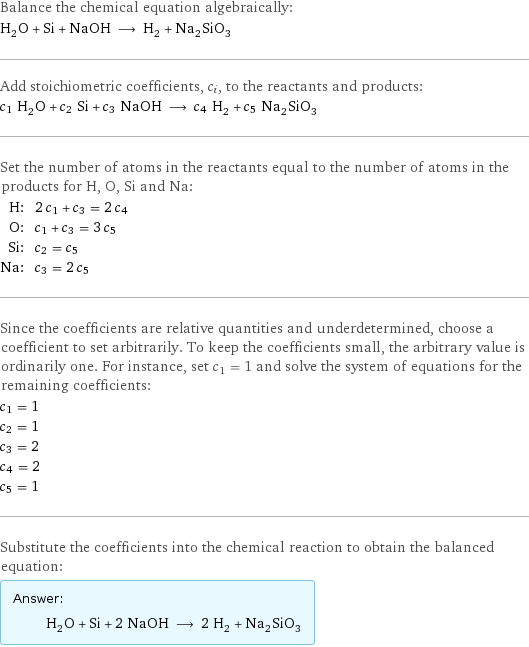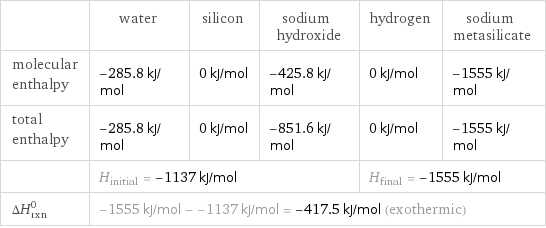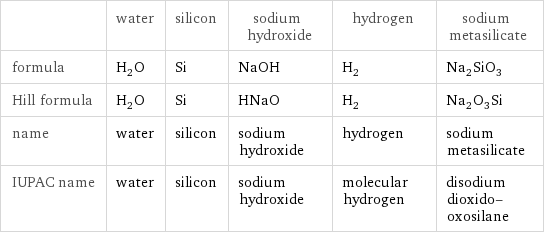Input interpretation

H_2O water + Si silicon + NaOH sodium hydroxide ⟶ H_2 hydrogen + Na_2SiO_3 sodium metasilicate
Balanced equation

Balance the chemical equation algebraically: H_2O + Si + NaOH ⟶ H_2 + Na_2SiO_3 Add stoichiometric coefficients, c_i, to the reactants and products: c_1 H_2O + c_2 Si + c_3 NaOH ⟶ c_4 H_2 + c_5 Na_2SiO_3 Set the number of atoms in the reactants equal to the number of atoms in the products for H, O, Si and Na: H: | 2 c_1 + c_3 = 2 c_4 O: | c_1 + c_3 = 3 c_5 Si: | c_2 = c_5 Na: | c_3 = 2 c_5 Since the coefficients are relative quantities and underdetermined, choose a coefficient to set arbitrarily. To keep the coefficients small, the arbitrary value is ordinarily one. For instance, set c_1 = 1 and solve the system of equations for the remaining coefficients: c_1 = 1 c_2 = 1 c_3 = 2 c_4 = 2 c_5 = 1 Substitute the coefficients into the chemical reaction to obtain the balanced equation: Answer: | | H_2O + Si + 2 NaOH ⟶ 2 H_2 + Na_2SiO_3
Structures

+ + ⟶ +
Names

water + silicon + sodium hydroxide ⟶ hydrogen + sodium metasilicate
Reaction thermodynamics
Enthalpy

| water | silicon | sodium hydroxide | hydrogen | sodium metasilicate molecular enthalpy | -285.8 kJ/mol | 0 kJ/mol | -425.8 kJ/mol | 0 kJ/mol | -1555 kJ/mol total enthalpy | -285.8 kJ/mol | 0 kJ/mol | -851.6 kJ/mol | 0 kJ/mol | -1555 kJ/mol | H_initial = -1137 kJ/mol | | | H_final = -1555 kJ/mol | ΔH_rxn^0 | -1555 kJ/mol - -1137 kJ/mol = -417.5 kJ/mol (exothermic) | | | |
Equilibrium constant
![Construct the equilibrium constant, K, expression for: H_2O + Si + NaOH ⟶ H_2 + Na_2SiO_3 Plan: • Balance the chemical equation. • Determine the stoichiometric numbers. • Assemble the activity expression for each chemical species. • Use the activity expressions to build the equilibrium constant expression. Write the balanced chemical equation: H_2O + Si + 2 NaOH ⟶ 2 H_2 + Na_2SiO_3 Assign stoichiometric numbers, ν_i, using the stoichiometric coefficients, c_i, from the balanced chemical equation in the following manner: ν_i = -c_i for reactants and ν_i = c_i for products: chemical species | c_i | ν_i H_2O | 1 | -1 Si | 1 | -1 NaOH | 2 | -2 H_2 | 2 | 2 Na_2SiO_3 | 1 | 1 Assemble the activity expressions accounting for the state of matter and ν_i: chemical species | c_i | ν_i | activity expression H_2O | 1 | -1 | ([H2O])^(-1) Si | 1 | -1 | ([Si])^(-1) NaOH | 2 | -2 | ([NaOH])^(-2) H_2 | 2 | 2 | ([H2])^2 Na_2SiO_3 | 1 | 1 | [Na2SiO3] The equilibrium constant symbol in the concentration basis is: K_c Mulitply the activity expressions to arrive at the K_c expression: Answer: | | K_c = ([H2O])^(-1) ([Si])^(-1) ([NaOH])^(-2) ([H2])^2 [Na2SiO3] = (([H2])^2 [Na2SiO3])/([H2O] [Si] ([NaOH])^2)](../image_source/a156120f541b6d5d4764b9737dbcb393.png)
Construct the equilibrium constant, K, expression for: H_2O + Si + NaOH ⟶ H_2 + Na_2SiO_3 Plan: • Balance the chemical equation. • Determine the stoichiometric numbers. • Assemble the activity expression for each chemical species. • Use the activity expressions to build the equilibrium constant expression. Write the balanced chemical equation: H_2O + Si + 2 NaOH ⟶ 2 H_2 + Na_2SiO_3 Assign stoichiometric numbers, ν_i, using the stoichiometric coefficients, c_i, from the balanced chemical equation in the following manner: ν_i = -c_i for reactants and ν_i = c_i for products: chemical species | c_i | ν_i H_2O | 1 | -1 Si | 1 | -1 NaOH | 2 | -2 H_2 | 2 | 2 Na_2SiO_3 | 1 | 1 Assemble the activity expressions accounting for the state of matter and ν_i: chemical species | c_i | ν_i | activity expression H_2O | 1 | -1 | ([H2O])^(-1) Si | 1 | -1 | ([Si])^(-1) NaOH | 2 | -2 | ([NaOH])^(-2) H_2 | 2 | 2 | ([H2])^2 Na_2SiO_3 | 1 | 1 | [Na2SiO3] The equilibrium constant symbol in the concentration basis is: K_c Mulitply the activity expressions to arrive at the K_c expression: Answer: | | K_c = ([H2O])^(-1) ([Si])^(-1) ([NaOH])^(-2) ([H2])^2 [Na2SiO3] = (([H2])^2 [Na2SiO3])/([H2O] [Si] ([NaOH])^2)
Rate of reaction
![Construct the rate of reaction expression for: H_2O + Si + NaOH ⟶ H_2 + Na_2SiO_3 Plan: • Balance the chemical equation. • Determine the stoichiometric numbers. • Assemble the rate term for each chemical species. • Write the rate of reaction expression. Write the balanced chemical equation: H_2O + Si + 2 NaOH ⟶ 2 H_2 + Na_2SiO_3 Assign stoichiometric numbers, ν_i, using the stoichiometric coefficients, c_i, from the balanced chemical equation in the following manner: ν_i = -c_i for reactants and ν_i = c_i for products: chemical species | c_i | ν_i H_2O | 1 | -1 Si | 1 | -1 NaOH | 2 | -2 H_2 | 2 | 2 Na_2SiO_3 | 1 | 1 The rate term for each chemical species, B_i, is 1/ν_i(Δ[B_i])/(Δt) where [B_i] is the amount concentration and t is time: chemical species | c_i | ν_i | rate term H_2O | 1 | -1 | -(Δ[H2O])/(Δt) Si | 1 | -1 | -(Δ[Si])/(Δt) NaOH | 2 | -2 | -1/2 (Δ[NaOH])/(Δt) H_2 | 2 | 2 | 1/2 (Δ[H2])/(Δt) Na_2SiO_3 | 1 | 1 | (Δ[Na2SiO3])/(Δt) (for infinitesimal rate of change, replace Δ with d) Set the rate terms equal to each other to arrive at the rate expression: Answer: | | rate = -(Δ[H2O])/(Δt) = -(Δ[Si])/(Δt) = -1/2 (Δ[NaOH])/(Δt) = 1/2 (Δ[H2])/(Δt) = (Δ[Na2SiO3])/(Δt) (assuming constant volume and no accumulation of intermediates or side products)](../image_source/22c54b1370f1e09e2589624b564b8427.png)
Construct the rate of reaction expression for: H_2O + Si + NaOH ⟶ H_2 + Na_2SiO_3 Plan: • Balance the chemical equation. • Determine the stoichiometric numbers. • Assemble the rate term for each chemical species. • Write the rate of reaction expression. Write the balanced chemical equation: H_2O + Si + 2 NaOH ⟶ 2 H_2 + Na_2SiO_3 Assign stoichiometric numbers, ν_i, using the stoichiometric coefficients, c_i, from the balanced chemical equation in the following manner: ν_i = -c_i for reactants and ν_i = c_i for products: chemical species | c_i | ν_i H_2O | 1 | -1 Si | 1 | -1 NaOH | 2 | -2 H_2 | 2 | 2 Na_2SiO_3 | 1 | 1 The rate term for each chemical species, B_i, is 1/ν_i(Δ[B_i])/(Δt) where [B_i] is the amount concentration and t is time: chemical species | c_i | ν_i | rate term H_2O | 1 | -1 | -(Δ[H2O])/(Δt) Si | 1 | -1 | -(Δ[Si])/(Δt) NaOH | 2 | -2 | -1/2 (Δ[NaOH])/(Δt) H_2 | 2 | 2 | 1/2 (Δ[H2])/(Δt) Na_2SiO_3 | 1 | 1 | (Δ[Na2SiO3])/(Δt) (for infinitesimal rate of change, replace Δ with d) Set the rate terms equal to each other to arrive at the rate expression: Answer: | | rate = -(Δ[H2O])/(Δt) = -(Δ[Si])/(Δt) = -1/2 (Δ[NaOH])/(Δt) = 1/2 (Δ[H2])/(Δt) = (Δ[Na2SiO3])/(Δt) (assuming constant volume and no accumulation of intermediates or side products)
Chemical names and formulas

| water | silicon | sodium hydroxide | hydrogen | sodium metasilicate formula | H_2O | Si | NaOH | H_2 | Na_2SiO_3 Hill formula | H_2O | Si | HNaO | H_2 | Na_2O_3Si name | water | silicon | sodium hydroxide | hydrogen | sodium metasilicate IUPAC name | water | silicon | sodium hydroxide | molecular hydrogen | disodium dioxido-oxosilane
Substance properties

| water | silicon | sodium hydroxide | hydrogen | sodium metasilicate molar mass | 18.015 g/mol | 28.085 g/mol | 39.997 g/mol | 2.016 g/mol | 122.06 g/mol phase | liquid (at STP) | solid (at STP) | solid (at STP) | gas (at STP) | solid (at STP) melting point | 0 °C | 1410 °C | 323 °C | -259.2 °C | 72.2 °C boiling point | 99.9839 °C | 2355 °C | 1390 °C | -252.8 °C | density | 1 g/cm^3 | 2.33 g/cm^3 | 2.13 g/cm^3 | 8.99×10^-5 g/cm^3 (at 0 °C) | 1.749 g/cm^3 solubility in water | | insoluble | soluble | | soluble surface tension | 0.0728 N/m | | 0.07435 N/m | | dynamic viscosity | 8.9×10^-4 Pa s (at 25 °C) | | 0.004 Pa s (at 350 °C) | 8.9×10^-6 Pa s (at 25 °C) | 1 Pa s (at 1088 °C) odor | odorless | | | odorless |
Units
